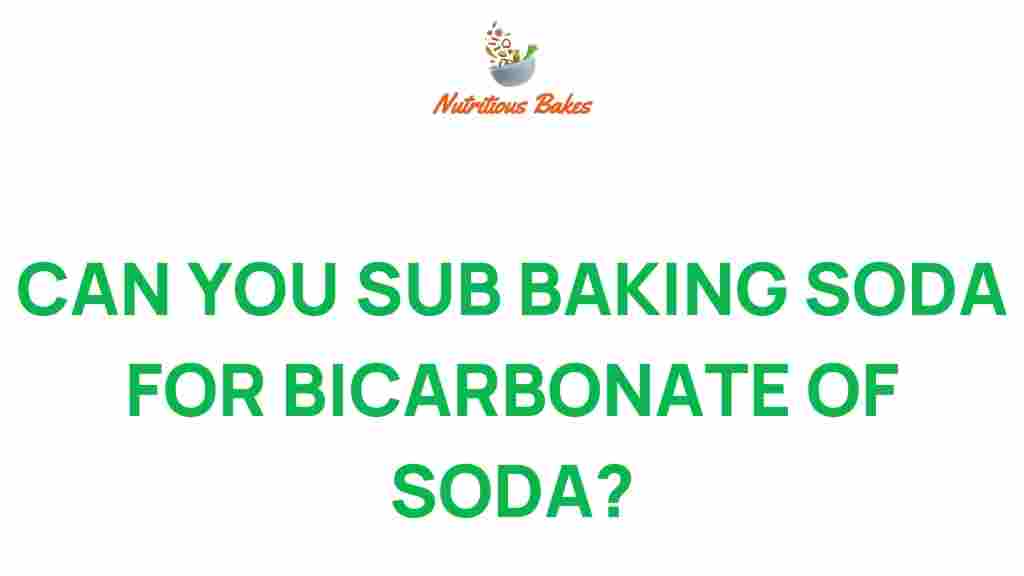The Great Baking Dilemma: Can You Substitute Baking Soda for Bicarbonate of Soda?
When it comes to baking, understanding the ingredients you use is crucial for achieving the perfect outcome. Among the many baking essentials, baking soda and bicarbonate of soda often confuse home cooks and professional bakers alike. Are they the same? Can you substitute baking soda for bicarbonate of soda? This article will explore the similarities and differences between these two ingredients, how to effectively swap them in your recipes, and provide you with valuable cooking tips.
Understanding Baking Soda and Bicarbonate of Soda
First, let’s clarify the terms. Baking soda and bicarbonate of soda refer to the same chemical compound: sodium bicarbonate. This compound is a leavening agent that helps baked goods rise. When combined with an acid, such as vinegar or lemon juice, baking soda releases carbon dioxide gas, creating bubbles that expand and cause the dough or batter to rise.
In many countries, the term “bicarbonate of soda” is commonly used, while in others, “baking soda” is preferred. Regardless of the name, they serve the same purpose in the culinary world.
Why Substitute Baking Soda for Bicarbonate of Soda?
Substituting baking soda for bicarbonate of soda typically arises in a few common scenarios:
- Ingredient Availability: You may find yourself running low on one ingredient and need to make a quick substitution.
- Recipe Instructions: Some recipes may use one term over the other, leading to confusion.
- Cooking Tips: Occasionally, you may want to experiment with ingredient swaps to achieve different flavors or textures.
The Substitution Process: How to Swap Baking Soda and Bicarbonate of Soda
Substituting baking soda for bicarbonate of soda is straightforward since they are essentially the same. Here’s a step-by-step guide to making the swap effectively:
- Check Your Recipe: Ensure that the recipe specifically calls for baking soda or bicarbonate of soda.
- Measure Carefully: Use the same amount for both ingredients. For instance, if the recipe calls for 1 teaspoon of bicarbonate of soda, use 1 teaspoon of baking soda.
- Acidic Components: If your recipe includes an acidic ingredient (like yogurt, buttermilk, or vinegar), make sure it’s balanced with the baking soda. This balance is crucial for optimal leavening.
- Mix Thoroughly: Ensure the ingredient is evenly distributed in the dry mix to prevent uneven rising.
Cooking Tips for Successful Baking
To ensure your baked goods turn out perfectly when substituting ingredients, keep the following cooking tips in mind:
- Temperature Matters: Make sure your ingredients are at room temperature to improve the chemical reactions.
- Don’t Overmix: Overmixing can lead to tough textures. Mix just until combined.
- Use Fresh Ingredients: Make sure your baking soda is fresh. Old baking soda loses its potency, affecting the rise of your baked goods. A simple freshness test is to mix a bit of baking soda with vinegar; it should fizz vigorously.
Troubleshooting Common Issues
Even with the best intentions, things can sometimes go wrong in the kitchen. Here are some troubleshooting tips for common issues when substituting baking soda for bicarbonate of soda:
- Flat Baked Goods: If your cookies or cakes are flat, it might be due to expired baking soda. Always check the expiration date.
- Too Much Rise: If your baked goods have risen too much and then collapsed, it could be due to excessive leavening. Use the correct measurement to avoid this.
- Unpleasant Taste: Using too much baking soda can lead to a soapy or bitter taste. Ensure you’re measuring accurately.
Exploring Ingredient Swaps Beyond Baking Soda
Ingredient swaps can be a fun way to explore new flavors and textures in your baking. Here are a few additional swaps you might consider:
- Self-Raising Flour: If you’re out of baking soda, you can use self-raising flour, which contains baking powder.
- Potassium Bicarbonate: If you need a sodium-free alternative, potassium bicarbonate can serve as a substitute, but you’ll want to adjust the amount slightly.
- Yeast: For some recipes, you can replace baking soda with yeast, although this will change the texture and flavor profile significantly.
Kitchen Hacks for Effective Baking
Here are some kitchen hacks to enhance your baking experience and make ingredient swaps easier:
- Labeling Ingredients: Keep your baking essentials organized and labeled to streamline the cooking process.
- Use a Digital Scale: Weighing ingredients can improve accuracy, especially when substituting ingredients.
- Batch Prep: Prepare larger quantities of dry mixes ahead of time, including baking soda mixtures, to save time on busy baking days.
Conclusion
In conclusion, the great baking dilemma of whether you can substitute baking soda for bicarbonate of soda can be resolved with confidence: they are interchangeable. Understanding the role of these ingredients in your baking will help you create delicious treats without worry. By following our cooking tips and utilizing the substitution process outlined above, you can ensure successful baking every time.
For more culinary science insights and ingredient swaps, check out our cooking resources. Happy baking!
This article is in the category Tips and created by NutritiousBakes Team
